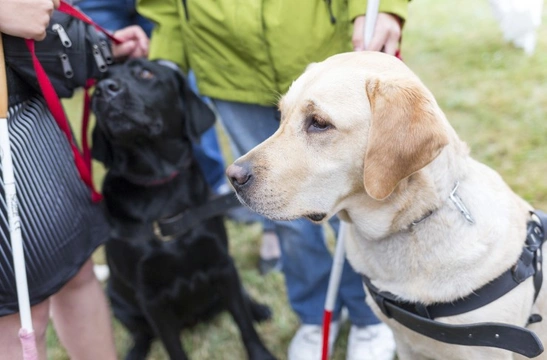
How to treat a working assistance dog when out and about
Assistance dogs are an invaluable part of independent living for many people, and they can help blind or deaf people to navigate the world, as well as being put to work in a huge range of other areas, such as as support for people with anxiety issues, autism, or those who have a chronic health condition such as diabetes.
Most dog owners know only too well how hard it can be to pass up on the chance to say hello to another dog when out and about, but when it comes to assistance dogs, it is very important to ensure that you do not distract or interfere with a dog that is working. Encompassed within this is the importance of respecting the rights of their handler to go about their business without constantly having to stop while people play with their dog!
However, this doesn’t mean that you must necessarily ignore assistance dogs altogether, and many people who benefit from having an assistance dog will be only too pleased to have a chat under the right situations, and this can also provide an additional way for people who might otherwise be rather isolated to meet new people and make friends.
In this article, we will look at how you should treat an assistance dog at work and at play, and some do’s and don’ts that all conscientious dog lovers should follow. Read on to learn more.
Working or off duty?
When an assistance dog is actively working and helping their handler, they will be wearing a clearly marked harness to denote this. This serves two purposes-first of all it alerts the general public that this is a working dog and gives them the chance to make allowances for this-such as by moving out of the way if the dog’s handler is blind or partially sighted.
Additionally, assistance dogs are trained to know that when their harness is on, they are in work mode, and should take things seriously. When simply on a lead or out of their harness, the dog in question may be playing and relaxing, just like any other dog in the dog park.
Pups in training
Before an assistance dog can go on to their handler, they go through intensive training first, including spending the first year of their life living with a puppy walker.
Puppies at this stage will wear identification to this effect on their collar and lead, and while they are not yet trained, are permitted to go into all of the usual places that a trained assistance dog can. This is in order to ensure that the pup is exposed to all of the different types of situations that they will have to deal with when at work, and to socialise and get them used to things.
If you can see a handler that is obviously actively training or working with their dog, do not disturb them-but if you spot a puppy walker out and about say, enjoying a coffee, it is ok to ask if you can pet the dog, or strike up a conversation with the handler. Puppy walkers expect this, to a certain extent, and all of these little interactions are valuable for the pup-but remember that they are not a tourist attraction, and to respect people’s personal space!
Speaking to the owner
If you wish to say hi to an assistance dog, always speak to their owner first, as this is simply good manners. If the dog is working, do not disturb them-but it is of course fine to offer polite assistance, such as if a blind person is navigating s strange area. Offer to assist, but always take no for an answer, and don’t be pushy, or assume that the handler will have time to chat to you!
Striking up a casual conversation about the dog’s name, age and other elements is a good start, as like other dog owners, those with assistance dogs are usually keen to meet other dog lovers!
Speaking to the dog
Ask before you pet the dog, and never give them a treat-again, this is just good manners. Also, make sure that you don’t delay the handler cuddling their dog if they are clearly trying to get somewhere!
Etiquette with children
If you spot an assistance dog out and about with your children, take the opportunity to teach them about what the dog does, how it is being handled, and the important job it does. You should also teach your kids from the get-go never to disturb a working dog, and to behave nicely around them.
It is also a good idea to teach your children about the ways in which people with partial sight or hearing navigate the world, and how they may be able to help or make things easier for them, as well as how not to get in the way!
Etiquette with your own dog
Assistance dogs need play, exercise and socialisation just like any other dog, so you may well see one playing in the park regularly, or relaxing off duty. At these times, simply treat the dog like any other dog, but if you encounter an assistance dog out working, make sure that your dog does not interrupt or make a nuisance of themselves.



